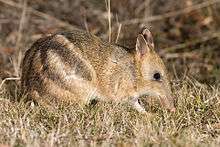Peramelidae
| Peramelidae | |
|---|---|
 | |
| An eastern barred bandicoot | |
| Scientific classification | |
| Kingdom: | Animalia |
| Phylum: | Chordata |
| Class: | Mammalia |
| Infraclass: | Marsupialia |
| Order: | Peramelemorphia |
| Family: | Peramelidae Gray, 1825 |
| Subfamilies and Genera | |
|
Peramelinae Echymiperinae | |
The Peramelidae family of marsupials contains all of the extant bandicoots. One known extinct species of bandicoot, the pig-footed bandicoot, was so different from the other species, it was recently moved into its own family. Four fossil peramelids are described. They are found throughout Australia and New Guinea, with at least some species living in every available habitat, from rainforest to desert.
Characteristics
Peramelids are small marsupials, ranging in size from the mouse bandicoot, which is 15-17.5 cm long, to the giant bandicoot, which at 39-56 cm in length and up 4.7 kg in weight, is about the size of a rabbit. They have short limbs and tails, smallish, mouse-like ears, and a long, pointed snout.[1]
Peramelids are omnivorous, with soil-dwelling invertebrates forming the major part of their diet; they also eat seeds, fruit, and fungi. Their teeth are correspondingly unspecialised, with most species having the dental formula 5.1.3.43.1.3.4
Female peramelids have a pouch that opens to the rear, and contains eight teats. The maximum litter size is, therefore, eight, since marsupial young are attached to the teat during development, although two to four young per litter is a more typical number. The gestation period of peramelids is the shortest among mammals, at just 12.5 days, the young are weaned around two months of age, and reach sexual maturity at just three months. This allows a given female to produce more than one litter per breeding season, and gives peramelids an unusually high reproductive rate compared with other marsupials.[1]
Classification
- Family Peramelidae
- Subfamily Peramelinae
- Genus Crash†[2]
- Crash bandicoot† (fossil)[3]
- Genus Isoodon: short-nosed bandicoots
- Golden bandicoot, Isoodon auratus
- Northern brown bandicoot, Isoodon macrourus
- Southern brown bandicoot, Isoodon obesulus
- Genus Perameles: long-nosed bandicoots
- Western barred bandicoot, Perameles bougainville
- Eastern barred bandicoot, Perameles gunnii
- Long-nosed bandicoot, Perameles nasuta
- Desert bandicoot, Perameles eremiana† (extinct)
- Perameles allinghamensis† (fossil)
- Perameles bowensis† (fossil)
- Perameles sobbei† (fossil)
- Genus Crash†[2]
- Subfamily Peroryctinae
- Genus Peroryctes: New Guinean long-nosed bandicoots
- Giant bandicoot, Peroryctes broadbenti
- Raffray's bandicoot, Peroryctes raffrayana
- cf. Peroryctes tedfordi† (fossil)
- cf. Peroryctes sp.† (fossil)
- Genus Peroryctes: New Guinean long-nosed bandicoots
- Subfamily Echymiperinae
- Genus Echymipera: New Guinean spiny bandicoots
- Long-nosed spiny bandicoot, Echymipera rufescens
- Clara's spiny bandicoot, Echymipera clara
- Menzies' spiny bandicoot, Echymipera echinista
- Common spiny bandicoot, Echymipera kalubu
- David's spiny bandicoot, Echymipera davidi
- Genus Microperoryctes : New Guinean mouse bandicoots
- Mouse bandicoot, Microperoryctes murina
- Eastern striped bandicoot, Microperoryctes ornata
- Western striped bandicoot, Microperoryctes longicauda
- Arfak pygmy bandicoot, Microperoryctes aplini
- Papuan bandicoot, Microperoryctes papuensis
- Genus Rhynchomeles
- Seram bandicoot, Rhynchomeles prattorum
- Genus Echymipera: New Guinean spiny bandicoots
- Subfamily Peramelinae
References
- 1 2 Gordon, Greg (1984). Macdonald, D., ed. The Encyclopedia of Mammals. New York: Facts on File. pp. 846–849. ISBN 0-87196-871-1.
- ↑ Travouillon, K.J.; et al. (2014). "Earliest modern bandicoot and bilby (Marsupialia, Peramelidae and Thylacomyidae) from the Miocene of the Riversleigh World Heritage Area, northwestern Queensland, Australia". Journal of Vertebrate Paleontology. 34 (2): 375–382. doi:10.1080/02724634.2013.799071.
- ↑ http://palaeoevolving.passle.net/post/vp38va/the-real-crash-bandicoot#
- Groves, C.P. (2005). Wilson, D.E.; Reeder, D.M., eds. Mammal Species of the World: A Taxonomic and Geographic Reference (3rd ed.). Baltimore: Johns Hopkins University Press. pp. 39–42. OCLC 62265494. ISBN 0-801-88221-4.
- Schwartz, L.R. (2006). "A new species of bandicot from the Oligocene of Northern Australia and implications for correlating Australian Tertiary mammal faunas". Palaeontology. 49 (5): 991–998. doi:10.1111/j.1475-4983.2006.00584.x.
External links
- Gordon, G.; Hulbert, A.J. (1989). "Part 24: Peramelidae". Fauna of Australia Volume 1B Mammalia (PDF). Australian Biological Resources Study. Canberra, Australia: AGPS. ISBN 978-0-644-06056-1. Retrieved 12 February 2011.